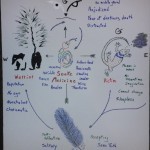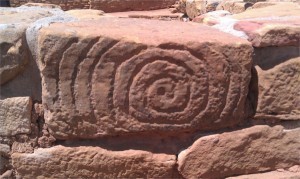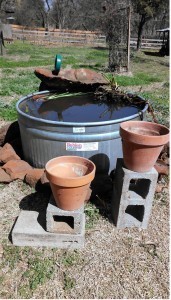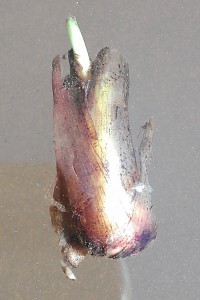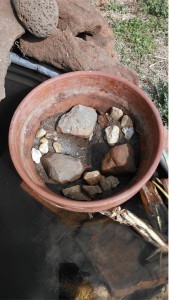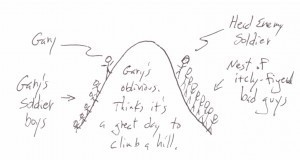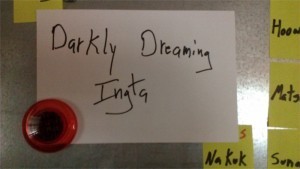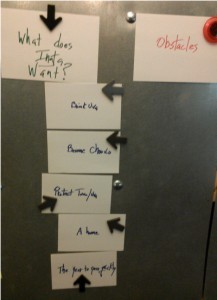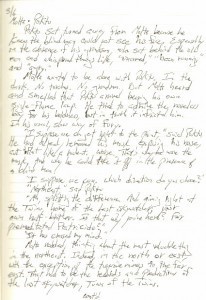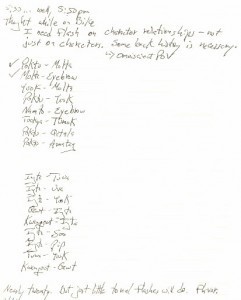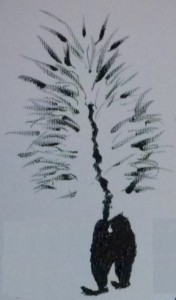Jeff Posey's Blog, page 8
May 5, 2014
Writing Novel Number 10, “Medicine Snake”: Week 12
Vision Board for “Medicine Snake”
Stories are circular, even though the ends never quite meet because setting and characters change by the time they come back around again. A perfect infographic for a story is the classic Anasazi icon of the spiral:
Week 12: Anasazi Spiral Photo by Jeff Posey, taken at Far View House in Mesa Verde National Park.
My vision board for Medicine Snake is a spiral in the correct direction, coming in from the east, turning left to the south, to west, to north, to center. That’s the spiral direction of life. The spiral direction of death is the opposite direction. Do I know this for certain? That the Anasazi thought this? No. I’m a novelist. I make stuff up. But when you walk into a Navajo hogan (link to good old Wikipedia), it’s good manners to enter the door that faces east and turn left to the south. A tiny little remnant of a universal constant of a sky-influenced society? The sun starts its day in the east, the arc of its travel curves to the south (more or less, depending on season), goes down in the west, and, some say, sleeps overnight in the north.
What does that mean for my story? One of the things about a spiral is that it nearly touches the line it’s matching as it corkscrews around in a counter-clockwise direction (if it’s a life spiral), as close to a past moment as a future moment.
I love that.
It’s spring here and I moved our pond from a place where it was failing (unfixable bottom leak) into a new above-ground pond:
Week12: Horse Trough Pond Under Construction
My father says we may attract horses to our back yard with a pond like this, but so far, only birds have dipped their beaks into the water.
Anyway, my point is, a tiny piece of one of the Pickerel rush (link to Lady Bird Johnson wildflower database) plants broke off, and I’ve been watching it float around. The mother plant is huge. I had to break it into three pieces just to lift it from the old pond, and I’ll probably end up sending most of it to the compost pile. But this one little piece, the size of the end joint of my little finger, could probably root out and become as big a pickerel plant as I allowed it to be.
Week12: At first I thought it was a dead grasshopper from last year floating in the water. Then I saw the green growth. It’s a tiny shoot of a Pickerel rush.
In fact, I’ve planted it alone in a partially submerged flower pot to see if it takes off:
Week 12: Raised pot with little piece of Pickerel rush planted in it.
That little pickerel joint makes me think about the tiniest bit of story idea that can grow into the biggest story. I’ve been trying to reduce it to its minimum for decades, but this is about as slim as I can make it:
A character
Who wants something
But there are obstacles
No character, no story.
No desire, no story.
No obstacles, no story.
Everything else is negotiable decoration.
So now I imagine the surging refugees and escapees and fortune-seekers from the failing cultures to the ancient nations to the south of Anasaziland, the Maya and Toltec, the same fertile precursors to the Aztec (which bloomed after the Anasazi were long gone). At the same time as the Anasazi were the Cahokia (link to Wikipedia) nations (should that be plural? Maybe not) to the far northeast near modern-day Saint Louis, and all sorts of less-organized clans and tribes scattered like dark matter through the North American continent of a thousand years ago. A spiral of activity. Individual and collective wants among every one of them, and obstacles galore, most dramatically the obstacles caused by humans fighting and preying upon and resisting other humans.
Stories without end.
And this one? This Medicine Snake story? In the late 1,000s, around 1090 when this story is set (I have a massive timeline in an Excel spreadsheet—I’ll figure out how to put that up here in a few weeks; I need it for online reference), the Anasazi themselves are beginning to break apart. Power shifts from Center Canyon (Chaco) north to the North Towns at the confluence of the northern tributaries to the current San Juan River, and thence toward the Cliff Villages (Mesa Verde), and then south and ultimately east back to the banks of the Rio Grande.
A death spiral of an entire nation.
That’s the context of my Anasazi novels. Of this story.
Ingta, my main character, wants something. But Molta, my antagonist, causes obstacles.
Blink: story.
April 28, 2014
Writing Novel Number 10, “Medicine Snake”: Week 11
Vision Board for “Medicine Snake”
Time for a map of my world, a fictionalized thousand-year-old overlay onto the archaeological remnants of the Anasazi.
Let’s start with this great map from Wikipedia:
Week 11: Map of the Ancients in the Southwesteern U.S.
Creative Commons Credits: http://en.wikipedia.org/wiki/File:Ancient_Cultures2.svg#filelinks
The major locations are:
Center Canyon, today’s Chaco Canyon, New Mexico (link goes to National Park Service site). This is on a line five hundred miles due north of Casas Grande (link takes you to Wikipedia) in Mexico, which flourished roughly along with the Anasazi (their peak was a little after the Anasazi).
North Towns, New North Town and Old North Town (the ruins we see today in Aztec [link to National Park Service site], and Bloomfield [link to private Salmon Ruin site], in New Mexico). The Great North Road (Wikipedia link) runs nearly to the Bloomfield site from Center Canyon.
The Twins, modern-day Chimney Rock National Monument in Colorado (link to not-for-profit organization that administers the monument), the center of my fictional world and home to my enduring main character Tuwa, the last skywatcher. It’s fifty miles northeast of the North Towns, a hundred miles from Center Canyon, twenty miles west of hot springs village (lowercase because it’s an informal gathering of huts and soaking baths without a leader or guiding council), today’s Pagosa Springs, Colorado.
Cliff Villages, today’s Mesa Verde National Park (Wikipedia link), eighty miles due west of The Twins.
Bluestone Mines, the ancient turquoise mines near Cerillos, New Mexico, (not far from Santa Fe) a couple hundred miles slightly south of due east from Center Canyon.
Ball Court People, the contemporaneous Anasazi culture west of Center Canyon, now referred to as the Hohokam Culture (Wikipedia). They seem to have been pretty insulated from the Anasazi, partially by the natural barrier of the Chuska Mountains (Wikipedia) that separated them. Interesting to note that the majority of construction timbers used in Chaco Canyon originated from the Chuska Mountains, fifty miles due west.
Southern Ancient Nations: Look up anything you want on the Toltecs and Maya. Their empires came before Anasaziland came to be, and were in the fits and starts of collapse and recollapse when the Anasazi got going—in fact, it was probably a compelling reason the Anasazi developed the culture and built the architecture they did. See almost anything by Professor Steve Lekson (his website: http://stevelekson.com/).
Now here’s my hand-drawn map:
Week 11: Jeff’s Hand-Drawn Map for his Anasazi Novels (click to enlarge)
Those angle marks are mountains. And the blue claw-like thing is the San Juan River, which flows into the Colorado River. The Rio Grande headwaters are just off the map in the far upper right. The town of Durango, Colorado, sits roughly between the Cliff Villages and the Twins. Yep. The mountain tribe of the Oots get Purgatory.
Maps make you daydream. I look at this, and I ask, what if most of these places, these cultures, had frequent contact? What if runners and messengers went back and forth along the roads, along with traders and the equivalent of soldiers? Information is drama. What characters choose to do with new information is drama.
For my story, I think about point-of-view shifts in which we’re in the chambers of the leader(s) of any of these places when a runner arrives with news. How they respond. What message they send back with a runner.
I recently watched the National Geographic documentary “Dawn of the Maya” (link to IMDB movie database), and one of the many things that happens in a society driven by an elite class is the extreme waste of scarce natural resources. The Maya, for instance, had a love for lime plaster, made from firing limestone at high temperatures using green wood as fuel. In some of their ruins, the floors were nearly a foot thick with lime plaster. Some speculate this helped push their culture to the brink—they burned up all their trees making plaster, which caused the streams and swamps to silt up, which reduced their ability to farm (they apparently harvested fertile soil from the swamps to make productive gardens), which, of course, killed their culture.
Did the Anasazi do something similar? Most likely. All top-heavy cultures in history have failed. The only ones that have sustained themselves over long periods of time are the simplest, least-stratified cultures. I just read a fascinating essay on exactly that: “Power and Efficiency in Eastern Anasazi Architecture: A Case of Multiple Evolutionary Trajectories,” by David E. Stuart in Anasazi Architecture and American Design (link to Amazon), edited by Baker H. Morrow and V.B. Price. Great reading. I highly recommend that chapter in this book of intriguing essays.
Okay. That’s enough for this week. Once again, I too easily go down a tiny side path. That’s why I stay off social media.
April 21, 2014
Writing Novel Number 10, “Medicine Snake”: Week 10
Vision Board for “Medicine Snake”
I think I’ll start occasionally reporting cumulative time and how it’s broken out. That’s how I track it anyway (using a timesheet app for my Android phone from here: http://timesheet.rauscha.com).
Here’s how the fifty-nine total hours I’ve spent on Medicine Snake by category look in a hand-drawn pie chart:
Week 10: The Pie Chart of 59 Cumulative Hours
Daydreaming is anything that does not result in cumulative word output. You know, hanging out with the characters.
Marketing is writing this blog. What else could I call it? Lots of things. But I don’t.
Research is research.
This question preoccupied part of my week: What does my protagonist want most? So I made a list.
Ingta wants:
Uva, a woman he can’t have and who is spending a sequestered year as the first female skywatcher’s apprentice.
To protect Uva, Tuwa, and the sacred Twins (modern-day Chimney Rock National Monument) where the skywatcher’s platform sits (and the village attached).
A home. Poor boy’s never had a real home.
The year to pass quickly so he can consort once more with Uva if she’ll have him.
Become like Tuwa’s best friend Choovio, who was the top man at the village of the Twins for decades, a quiet, solid man with a powerful wife.
Now, what does the antagonist want?
Molta, the High Priest of Center Canyon (modern-day Chaco Canyon, New Mexico) wants:
Gain control of the North Towns, New North Town and Old North Town (the ruins we see today in Aztec and Bloomfield, New Mexico). The ancient Southern nations to the south demand it.
In the process, gain control of the magnificent pottery made by a mysterious woman who lives outside of New North Town.
Lure the last skywatcher, Tuwa of the Twins, to his influence.
Remove anyone who gets in his way.
Be recognized by the Southern nations as worthy of a temple greater than the best of Center Canyon.
Okay. Enough of that. It’s always good to clarify what the two opposing characters want.
The story is finally beginning to take shape in my mind.
April 14, 2014
Writing Novel Number 10, “Medicine Snake”: Week 9
Vision Board for “Medicine Snake”
I’m progressing slowly with this story. Lots of distractions. Lots of contract work, yard and garden work, family events and such. And I’m still laying hard into preparing Price On Their Heads for the next step of publication—mainly reading it out loud. I’m a little more than a third through that.
Nevertheless, I’ve written some intriguing flash, ideas about setting up the story, possible entries into it. Here’s the most intriguing from this week:
Tookya and Pip Flee to the Twins“There,” said Tookya, pointing.
Pip looked and signed no. He didn’t see.
Tookya stood beside him, head behind Pip’s, and pointed along his arm. From the tip of his finger the Twins rose in the distance, like two fingers of dark gray against a background of diffused gray.
“Oh, I see,” said Pip. “That’s where we’re going?”
In answer, Tookya started walking. He crunched through the snow and stepped high to keep from dragging his feet, but Pip, much smaller, plowed from step hole to step hole behind Tookya. They were high in the mountains, looking down on the Twins two or three days’ distant, no trail, only drift after drift of snow, some thawed and refrozen close enough to the surface to walk with almost a normal swing of the leg, but others, mostly those in shadow from the southerning sun, were loose or, worse, powder. Then they would wallow through the snow, Pip making a swimming motion.
Two days later, Tookya once again pointed, and there the Twins stood above them, backlit by the setting sun, two great sandstone spires pointing to the stars. Tookya had heard of them since childhood, and so had Pip, but neither had laid eyes on them before. The mythical Twins of the First World, now frozen in place in the Fourth. Home of the last skywatcher.
“We can get there before dark!” said Pip.
Tookya held back. “No. Approach is from the south. Up the tilt to the top. Tomorrow.” He began looking around for a place to cold camp. Pip joined him against the base of a spruce, a hollow in the snow, and they shivered through the night, and the next day when the sun climbed to its highest, they entered the lower village of the Twins. Several older boys ran up to them, asked who they were.
“Tookya and Pip from south of the eastern mountains. We seek council with the last skywatcher.”
The boys ran ahead to alert the adults, and soon men appeared, most with tools they could use as weapons if necessary, and Tookya felt they were walking a gauntlet. One man held two large hammerstones, one in each hand, his arms bare to the cold, muscles bulging. Most held sticks. A woman stood with a longbow at her side, the feathers of arrows behind her neck from a full quiver.[i]
A boy about the age of Pip, but longer of limb and his head oversized, arrived to escort them to the big house behind Master Tuwa’s sky circle.
“What’s your name?” asked Pip.
The boy grinned and looked away, bending his neck at an odd angle. “Gawt is my name. Some call me Echo Boy, and I don’t mind.”
“Why do they call you that?”
“Why do they call you that?” Gawt asked, and they both laughed.
Tookya shook his head at the juvenile joke, and at the top he saw a man waiting. He had straight legs and straight back, his hair long and black, and he stood bending his knees, rocking his weight back and forth, as runners do, anxious for the race to begin.
When they reached the man, he thanked Gawt, who slinked away.
“Can I go with him?” Pip asked the man.
Gawt turned and looked. The man made a hand sign to Gawt, who replied that he didn’t mind. “Yes,” the man said to Pip, “go.”
Pip scampered after Gawt and they ducked into a doorway.
“You have been announced as Tookya and young Pip from south of the mountains to the east.”
“Yes.”
“I am Ingta. Do you carry weapons?”
Tookya raised his hands and spread his arms. “I do not.” It made him feel naked. He rarely carried no weapon, but he did not wish to threaten in any way the last skywatcher, so he left them below the tilted Twins mesa, stashed behind a rock that jutted out of the snow like a single jackrabbit ear.
“Good. Follow me. We have a fire, drink, food, and then we can have a word with Master Tuwa in his chamber.”
After he had warmed and quenched his hunger and thirst, Ingta led Tookya up a ladder to a flat roof swept clear of snow by wind or broom, and down another ladder through an opening in the middle of the roof. They climbed down into the chamber of Master Tuwa, a great round room, fire in the middle, cleansing smoke trailing up through a square hole of bright light, the early afternoon sun angling from the opening to the floor, smoke and dust swirling in the intense light.
Master Tuwa sat cross-legged on the floor in the oblong square of light. Another man sat in the shadows to Tuwa’s left. At the bottom of the ladder, Tookya followed Ingta, who went to the east wall and turned south, hugged the wall all the way around until they were at the north side, and only then did he introduce Tookya to Master Tuwa.
“Welcome, Tookya of the East. With me is Nanatoona, Master Bone Rattler, of the North.”
Tookya sat and slouched to keep his head lower than Master Tuwa’s. In spite of the bright, cold day outside, the room was warm and still. Dark, but not gloomy, smoky but the air breathable. A young boy tended the fire, and then disappeared into flickering shadows.
“I know you,” said Nanatoona in a high old man’s voice. “You are the only one who spoke against Tumok.”
“That is true,” said Tookya. He knew Nanatoona as well, and he held him in low opinion. The predictions of the old bone rattler were what made Tumok do what he did. “And I will speak against those who guide and encourage him, as well.”
Tuwa sat with a half grin, his eyes half closed. Ingta braced himself with an outstretched leg.
Nanatoona laughed, a wheeze like an old man and tree branches in a stiff breeze. “The bones never lie. But men often do.”
Tookya tensed and straightened. “I do not lie.”
“No,” said Nanatoona. “But Tumok cannot boast the same. You and he are not like the others in your village. They are see nothing and have no motivation, but Tumok sees things and takes them, and you see what is unfair and fight it.” The old man laughed his airy, wheezy way again. “The battle of the ages, between greed and justice. The world will vibrate between those two opposites forever, like these twins that used to stand at the poles and steady the world so that we could live on it, and now they are frozen here forever, letting any tempest blow past without so much as a blink or a nod, even their strength exhausted.”
“What,” asked Tuwa, opening his eyes and looking at Tookya, “is it Tumok has done?”
[i] Kwivi, West, attendant to Sooveni
The Twins is Chimney Rock Archaeological Area near Pagosa Springs, Colorado.
April 7, 2014
Writing Novel Number 10, “Medicine Snake”: Week 8
Vision Board for “Medicine Snake”
I sat back and rode upright on the stationary bike when it hit me: Is my intent to have maximum dramatic effect?
I’ve learned, or realized that I really already knew, lots of things about dramatic plot in writing nine novels. It’s less about what happens, and more about why it happens to who. And point of view is an extremely powerful tool. Drama, in fact, is probably the only real storytelling reason to change points of view (comedy could justify it, too).
For instance: Gary and ten soldiers are marching up a hill, tired and hot and grumpy. Over the crest of the hill is a nest of two dozen enemy soldiers, alert and with itchy trigger fingers. If our POV is locked into Gary’s head, then we can’t let readers know a bunch of bad guys are over the hill (unless Gary finds out), and therefore the plot doesn’t thicken, it thins. It supercharges the plot to switch POVs, or go to an omniscient or narrator’s POV to point out the bad guys. Oh no! Gary and his boys are in trouble!
Week Eight: The Hill
Also, there’s something deeper. If you’re in, say, third person, can you tell the reader anything about the subconscious of the character? If the character doesn’t know it, then he can’t think it, and if he can’t think it, the reader can’t know it. That’s why it’s so easy to float up into omniscience, which can get a bit freaky for a reader. Suddenly their character is having an out-of-body experience! They even think things about themselves that they don’t and can’t know!
For Medicine Snake, I do indeed want to write it for, if not maximum, at least strong dramatic effect. Hence I need to think more about my POV characters. And why they’re making what happen to who.
Meanwhile, I’m still slowly reading my last novel, Price on Their Heads, out loud as its final polish. I’ve spoken so much of it, I’m hoarse.
March 31, 2014
Writing Novel Number 10, “Medicine Snake”: Week 7
Vision Board for “Medicine Snake”
Me bad writer. I spent a total of one hour this week working on my Anasazi historical novel Medicine Snake. Instead, I spent nearly twenty hours editing and reading my last contemporary novel (with an Anasazi angle) out loud, Price on Their Heads, to prep it for publication. I have a very hard time switching from one story to another. I’m a one-story-at-a-time kind of guy. I wish I weren’t, but it’s pretty obvious.
During my one hour, though, I did have a near-revelation:
Week Seven: Darkly Dreaming Ingta
One of the things I realize from eight of my nine prior novels is that my protagonists tend to be weaker than my antagonists. Of course—bad guys are more fun to write than good guys.
So what if I flipped that? Made my protagonist for Medicine Snake, Ingta, have a dark side? What if he’s on a mission to take it straight to the real antagonist (Póktu and his master, old blind Molta)?
It’s something to think about. And yes, the “darkly dreaming” is from the book Darkly Dreaming Dexter (link to Amazon), by Jeff Lindsay, inspiration for the TV show Dexter.
I love the opening of the description for that book: “Meet Dexter Morgan, a polite wolf in sheep’s clothing.” Meet Ingta, who is not what he seems.
That’s always a good brain tease for a character.
Goal for next week: Finish jacking with Price on Their Heads and spend more time on Medicine Snake.
March 24, 2014
Writing Novel Number 10, “Medicine Snake”: Week 6
Vision Board for “Medicine Snake”
Sigh. Time spent: 4.0 hours. A hundred percent daydreaming, including writing flash exercise scenes.
My last novel came back from my first reader, and I’m going through that. He’s a great reader. Points out lack of character motivation, or things that don’t make sense to him in the bigger story arc. Exactly what I want from a first reader. So I’m going through and seeing lots of shiny things in the story I missed while I wrote the first draft. It’s great fun, very creative, but as a result of spending nearly fifteen hours this week going over Draft 2 of Price on Their Heads, I’ve kind of shorted Medicine Snake creative story development.
I did have a minor epiphany on the workout bike while staring at my storyboard. I’ve written several novels with no more original spark than this simple statement: “Three characters, one of whom wants something very much.” For some reason, that gives my imagination wings.
But I hadn’t really thought about Medicine Snake that way yet. Until it occurred to me when my heart was pumping around 155 beats per minute. A particularly good zone for me, by the way.
I made some storyboard notes about what my main character, Ingta, wants in this story:
Week Six Storyboard
That helps me think about what the story might be. And prompted me to write a critical flash work scene in which the two antagonists work to throw some obstacles at what Ingta wants:
Week Six Flash: Molta-Poktu
Molta – PóktuPóktu sat turned away from Molta because he knew the blind man could not see his face. Especially in the absence of his grandson, who sat behind the old man and whispered things like, “unarmed,” “been running,” and “angry.”
Molta wanted to be alone with Póktu. In the dark. No torches. No grandson. But Molta heard and smelled that Póktu arrived bearing his own single flame lamp. He tried to admire the noseless boy for his boldness, but in truth it infuriated him. In Molta’s usual, slow way of fury.
“I suppose we can get right to the point,” said Póktu. He had already removed his mask, exposing his nose, cut flat like a rodent’s. Worse. That’s why he wore the mask. And why he could take it off in the presence of a blind man.
“I suppose we can. Which direction do you choose?”
“Northeast,” said Póktu.
“Ah, splitting the difference. And aiming right at the Twins, home of the last skywatcher, your own half-brother. Is that why you’re here? For premeditated fratricide?”
“It has crossed my mind.”
Molta nodded, thinking about the most valuable thing in the northeast. Indeed, in the north or east, with the exception of the turquoise mines to the far east. And that was the long record and predictions of the last skywatcher, Tuwa of the Twins.
“Has it occurred to you, Master Chief Warrio,” Molta said to Póktu with more deference than he felt, “that the more the last skywatcher weakens, the more he will rely on us?”
Póktu shrugged. “I haven’t thought about it.”
“A direct assault on Master Tuwa would be disastrous. Our own people would see the extreme mistake. He must continue at all costs. But a little intentional crumbling around the edges might help push him in the right direction.”
Póktu nodded. Exactly. The old blind man actually showed him the way he could hurt Tuwa the most: take out his right-hand man, Ingta. And then go after the girl, Uva. Póktu allowed himself to grin.
That’s it for this week.
Goals for next week:
More character daydreaming, notes, flash.
Capture more scene ideas on the storyboard.
Keep daydreaming.
The story still eludes me. The setting is clear. Characters are becoming clear. But the storyline has yet to pop in my head. It’s hard not to be impatient. I may have to write a few thousand words into it before the story reveals itself to me. That’s fine. I’ll get there.
March 17, 2014
Writing Novel Number 10, “Medicine Snake”: Week 5
Vision Board for “Medicine Snake”
First, time stats for last week: 12.75 hours. All Daydream time, which includes writing flash scenes of characters and character relationships. All daydream, all the time. Not a bad life, eh?
Goals for last week:
Character sheets for main characters (do the ones I least want to do first).
Flash scenes for nearly twenty character relationships.
Capture scene ideas on the storyboard.
Keep daydreaming.
I didn’t do any character sheets. Of seventeen flash scenes I want to write, I’ve completed eleven. I’ve capture no new scene ideas for the storyboard, and I’ve been daydreaming a lot. So, not bad progress.
Opening?
As one of my flash exercises, I may have found my story opening. Or at least a possible story opening. Here it is as I wrote it in my journal, with a transcription below:
Novel #10 “Medicine Snake” Opening?
Ingta stood in the stone doorway with a cotton blanket around his shoulders, staring into the windy, frigid night. He didn’t want to go.
Not just because of the weather. But because he knew what would happen when he went out there. He would be sent away. For his own good. and he would go, but he would not like it.
A boy hustling with a cold riverstone came to the door. “He asked for you again.” The boy squeezed by with his stone.
Another boy from inside came holding a fire-heated stone, several layers of blackened animal hides to protect his arms. This boy, Ingta knew.
“He wants you,” said Hinti.
Ingta pulled the blanket tight and nodded his head to the elements. “I’ll follow you.”
Hinti looked back to make sure Ingta followed, and he took his first step into the middle of winter, about to be sent on some get-rid-of-him mission.
The wind bit into his face and neck and he huddled, his eyes watering. He blinked and glanced up, expecting to see scudding clouds, hoping to argue Tuwa back inside. But the sky, if anything, seemed magnified by the frigid air. That’s why the old man sat in the center of his circle of stones. That’s why the boys scuttled back and forth with the hot stones. To keep the last skywatcher from freezing to death.
Tuwa sat in a tent of blankets, hot stones piled around him, only his head sticking out, his frizzled gray hair twisting in the wind.
“Beautiful night,” he called to Ingta.
Ingta hugged his arms against his chest, the blanket tight across his back. He didn’t want to disagree with the master, so he said nothing.
“There is a man I want you to meet,” said Tuwa.
Ingta waited, politely, for him to add more, wishing he would hurry.
“You won’t like him. Or believe him, I should say. I’m not sure I do, either. But he will make you see and think things that need seeing and thinking.” Tuwa stared without blinking at Ingta, who wondered how the old skywatcher kept his eyeballs from freezing. “Will you do this for me?”
“Yes,” said Ingta. He would agree to a private meeting with the devil Másaw himself if he could get out of the cold wind.
“Good,” said Tuwa. “There is one thing you should know.”
Ingta waited, trying to relax through the shivers that prepared to take over his body.
“He’s a Bone Rattler. Arrived today. Recommended by that potter girl.”
“Sooveni,” Ingta said.
“Yes, Sooveni. She specifically asked him to cast your horizon.”
“She thinks I need guidance from a Bone Rattler?”
“She thinks it would help your judgment.”
Ingta sighed, and said again that he would do it. If only, for the moment, to get back inside and find a fire. He could brood about Sooveni and her lack of trust in his judgment later.
“He’ll surprise you,” said Tuwa. “But whether that is good or bad, I do not know.”
Goals for next week:
Character sheets for main characters (do the ones I least want to do first).
Flash scenes for remaining six of seventeen character relationships.
Capture scene ideas on the storyboard.
Keep daydreaming.
I still don’t quite know what the story is yet. But it’s percolating pretty good, and I expect it to start spewing soon. Meanwhile, I’ve already received my first editor’s review of novel #9, Price on their Heads: a Novel of Income Inequality and Mayhem. I’ll spend more time on a second draft of that this week than on Medicine Snake.
March 10, 2014
Writing Novel Number 10, “Medicine Snake”: Week 4
Vision Board for “Medicine Snake”
Let’s start with time:
11.0 hours, about 80 percent research (meaning reading past stories, looking at maps, etc.), 15 percent daydreaming (writing some flash and staring at my storyboard, usually while on my stationary bike), and 5 percent writing this blog.
I had a revelation this week. A few, really.
First revelation!
First is the title. After saying it out loud until it stopped meaning anything, I realized my mouth kept slipping and saying it the other way around: “Medicine Snake,” instead of “Snake Medicine.” I don’t know why yet, but I like it better. Hence I now have a new working title for the book: Medicine Snake.
The second revelation!
Duh! About half the characters in this story could and should come from the first two novels in the series. So I completely reorganized my character mirror chart.
Week4: Updated Character Chart
You know what I mean by mirror, right? See the line of red magnets splitting the character chart up the middle? To the right is the villain and his supporting cast. To the left is the hero, with his supporting network of characters. You don’t have to balance them or anything. Just look and think and daydream. Those are the roots of a good story.
Revelation the Third
Okay, I’m about tired of these revelations. This one’s it: More than I need to write flash scenes with each character, I need to write flash scenes for each important character relationship—two characters together. Their dynamic. Their little secrets and habits and ambitions.
Character Relationships to Flash, Week 4
So, I did manage to write three flash scenes focusing on a character moment, and I offer my favorite here.
Flash of the Kolitsi Warriors
A Kolitsi Warrior?
Póktu spotted the skunk men from the third level. Six men plus a leader had their long hair straight up, but loose and feathered, like a skunk’s tail raised in attack. Their hair and faces and bodies were painted black and white. They wore small unadorned loincloths and each man carried weapons in their hands, war clubs and flake knives, with a couple of short bows with arrows.
They marched around through the crowd, people reeling away, but they never approached or threatened any of Póktu’s men.
Póktu adjusted his mask, which he rarely took off, even to sleep. His half-brother, Tuwa, had cut the tip of his nose off, making him look hideous. Even with the mask, people stared. He knew they wanted to see the rabbit-nosed man. Sometimes, for effect, he showed them.
He snapped his finger to get the attention of his daydreaming captain. “Bring those to me.”
“Which ones?”
Póktu pointed with his war club. “The skunks.”
On an elevated platform in his quarters, Póktu received the skunk men, who strutted and stamped in orderly formation in spite of the dozen of Póktu’s largest men who escorted them.
“Sir!” said the captain. “I present Amataq and his Kolitsi Warriors!”
On cue, they spread in front of him and danced like Póktu had rarely seen, all body language of supreme confidence, no shaking or quaking or backing down, all reputation without the need to fight, all daring but without advance.
When they stopped, each man breathing deep but under complete control, Póktu tapped his club on the ground to show his admiration.
“Bravo, Amataq,” he said, nodding. “The perfect show for the kolitsi, the skunks—all reputation and confidence and no fight.”
“Likek the kolitsi, we fight if it is necessary,” said Amataq.
“Without putting up a stink?”
Amataq reached for a small pouch pinched in his waistband. “Few are willing to fight through the stink at our command.” He raised the small sack as if to fling it to the floor between them.
Póktu lifted his hand. “Please. Not here.”
Goals for next week:
Character sheets for main characters (do the ones I least want to do first).
Flash scenes for nearly twenty character relationships.
Capture scene ideas on the storyboard.
Keep daydreaming.
March 3, 2014
Anasazi Novels: Writing Number 10, “Snake Medicine”: Week 3
Total time spent this week: 16.5 hours. About half went to reading the first two novels in the series that precede Snake Medicine. The other two quarters went to daydreaming and staring at my storyboard (often on my exercise bike), and to writing up my notes for this diary.
My goals from last week were to:
Read Soo Potter and The Last Skywatcher, the two books in the series that occur before the book I’m writing. I simply needed to refresh my mind and feel the ongoing story again. I didn’t finish. As of this morning, I’m 72 percent through the second book. Nearly there.
Work up character sheets for each character. I accomplished zero on this.
Write flash scenes for each character. Again, zip. Nothing.
But what I did do was discover a cast of secondary characters I had simply forgotten to think about for this story. So I’m collecting them on my storyboard with little sticky notes:
Anasazi Novels: “Snake Medicine” Week 3: Characters from prior books in the series
Scenes Bubbling Out
And I couldn’t help myself. I began imagining scenes. I jotted notes on two scene cards and stuck them on my board:
Anasazi Novels: “Snake Medicine” Week 3: First two scenes for the storyboard
It’s a good time to point out the template of the scene cards I use.
First line: Setting
Second line: Scene Headline
Third line: Active Characters
All I want is an easy way to remember the scenes, scene sequences, and order and progression of scenes. I’ll build about a dozen scenes and scene sequences for each portion of the four-part basic hero’s journey: Victim, Seeker, Warrior, Victor.
That’s a goal of forty-eight scenes or scene sequences that I’ll play with on my storyboard. At 1,500 words per scene/sequence, that’s 72,000 words.
Storyboard
Here’s what my storyboard looks like now:
Anasazi Novels: “Snake Medicine” Week 3: The whole storyboard
I built it myself, and there are better ways to do it: Big stainless steel sheets mounted to boards that are then mounted to studs against the wall. I didn’t do the best job, but it works exactly like I want it to. A magnetic white board would also do the job. I just wanted something more, ah, quaint. Yeah. Something like that.
This is the third novel I’ve used with a technique like this, and it works well for me. I’ll come up with more scenes as I go, and change them often, but having the cards in order, usually like a deck of cards next to me while I write, helps me write more coherent stories that I like better.
The first time I wrote a novel using these little cards, I told my wife, “This is the first time I’ve felt like I wrote a novel rather than it wrote me.” I’d been a pure seat-of-my-pants writer until then. Now I think of these cards as guides while I’m writing by the seat of my pants.
Goals for next week:
Finish reading all the background.
Character sheets for each character.
Flash scenes for, well, let’s be realistic here: some of the characters.

